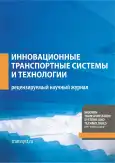Trends for sustainable development of ecomobility transportation systems
- 作者: Chechenova L.M.1, Volykhina N.V.1
-
隶属关系:
- Emperor Alexander I St. Petersburg State Transport University
- 期: 卷 7, 编号 4 (2021)
- 页面: 65-75
- 栏目: Original studies
- URL: https://bakhtiniada.ru/transj/article/view/90776
- DOI: https://doi.org/10.17816/transsyst20217465-75
- ID: 90776
如何引用文章
全文:
详细
Background: Nowadays, the transport industry faces unconventional challenges such as the need to modify the transport service and reduce dependence on resource leverage. At the same time, it is necessary to take into account the decline in business activity associated with the pandemic crisis and, as a result, the drop in demand and prices for hydrocarbon fuel in the medium term until the end of the crisis. Also, the implementation of a forward-looking transport policy has a close relationship with the economic category of time, since the value of time, converted into speed, shifts the emphasis of value from the initial price of the purchased transport service to the total cost of owning it. The railway transport system of the Russian Federation, as one of the leaders of the world transport system, has every opportunity to actively participate in global restructuring in response to the global climate and environmental crises.
Aim: Determination of the relationship between the adoption of a sustainable development policy and the effectiveness of the implementation of projects for the development of backbone infrastructure in Russia. We confirm that the activities of transport companies within the framework of the established sustainable development goals (hereinafter referred to as ESG – Environmental, Social, and Corporate Governance) contributes to the improvement of their operational activity.
Methods: The research methodology is based on the analysis of international approaches and assessment criteria for ESG factors using analytical procedures to identify cause-and-effect relationships of the strategy for the development of railway transport in the Russian Federation within the framework of ESG. The information base of the study is based on an analysis of reports from international organizations and data from JSC “Russian Railways” in terms of funding, expected prospects and effects.
Results: as a result of the study, the conditions for the transformation of the sustainable development of railway transport systems in the world and in the Russian Federation were determined against the background of changes in the geography and structure of commodity markets, favorable prospects were established from the direct participation of business in the implementation and implementation of the goals and objectives of sustainable development.
Conclusion: on the basis of the study, an assessment was made of the benchmarks of JSC “Russian Railways” in the sustainable development strategy. In order to implement environmental infrastructure projects, the parameters of the compliance of the strategy for the development of railway transport in Russia with the goals of sustainable growth have been established.
作者简介
Liana Chechenova
Emperor Alexander I St. Petersburg State Transport University
编辑信件的主要联系方式.
Email: liana1981-149@mail.ru
ORCID iD: 0000-0002-2641-9454
SPIN 代码: 7593-2214
PhD in Economics, Associate Professor of the Department of Transport Economics
俄罗斯联邦, St. PetersburgNatalia Volykhina
Emperor Alexander I St. Petersburg State Transport University
Email: natalyabatalova@yandex.ru
ORCID iD: 0000-0002-5948-7226
SPIN 代码: 4027-4771
Senior Lecturer of the Department of Transport Economics
俄罗斯联邦, St. Petersburg参考
- Wang X, Wong YD, Yuen KF, Li KX. Environmental governance of transportation infrastructure under Belt and Road Initiative: A unified framework. Transportation Research Part A: Policy and Practice. 2020;(139):189-199. doi: 10.1016/j.tra.2020.03.001
- Petriaev A, Svatovskaya L, Baidarashvili M, Sakharova A. Green technology with geosynthetics prevent environment from railway dangerous pollutants. In: 11th International Conference on Geosynthetics (ICG); 2018 Sep 16–21; Seoul, Korea; 2018. p. 1554-1560.
- Svatovskaya L, Drobyshev I, Mikhailova K, Khamenok N. Criteria of green geoecoprotective technologies in transport construction. Lecture Notes in Civil Engineering. 2020;(50):431-440. doi: 10.1007/978-981-15-0454-9_45
- Samir S, Venkatesh M, Haifa M, Muhammad S. Dynamic linkages between transport, logistics, foreign direct Investment, and economic growth: Empirical evidence from developing countries. Transportation Research Part A Policy and Practice. 2020;(141):277-293. doi: 10.1016/j.tra.2020.09.020
- Annual Report 2020. [Internet]. The World Bank. [cited 2021 June 7]. Available from: https://www.worldbank.org/en/about/annual-report
- Certified Bonds. Climate Bonds Initiatives. [Internet]. cited 2021 June 7]. Available from: https://www.climatebonds.net/certification/certified-bonds
- Изменение климата: влияние на финансовый сектор. [Izmenenie klimata: vliyanie na finansovyj sektor. [Internet]. (In Russ.)]. Ссылка активна на 07.06.2021. Доступно по: https://cbr.ru/press/event/?id=6823
- Global Infrastructure Hub. [Internet]. A G20 INITIATIVE. [cited 2021 June 7]. Available from: https://www.gihub.org
- Инвестиции в инфраструктуру. Экология. [Investicii v infrastrukturu. Ekologiya. [Internet]. (In Russ.)]. Ссылка активна на 07.06.2021. Доступно по: https://infraone.ru/sites/default/files/analitika/2020/investicii_v_ infrastrukturu_ekologiya_2020_infraone_research.pdf
补充文件












